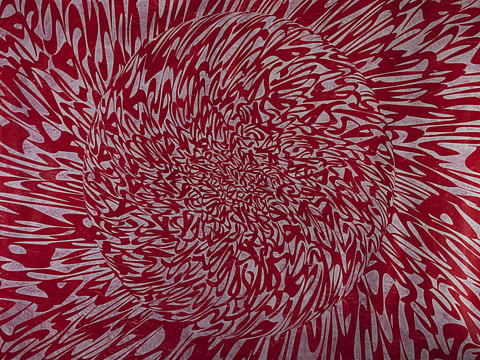Calligraphic expressions of spiritual space
An Iranian artist uses his engineering background to experiment with word forms and shapes

Iranian artist Mohammad Bozorgi is a leading figure among the new generation of contemporary calligraphers. After training with the Society of Iranian Calligraphers for over a decade and mastering various calligraphic scripts, he decided to leave the institution and liberate himself from the constraints of this formal, traditional training by experimenting with new ideas.
Bozorgi, who has a degree in Biomedical Engineering, combines his training as an engineer with his knowledge of Islamic calligraphy in his innovative paintings. He uses mathematical calculations and the intricate symmetry and pictorial invention of classical calligraphy to create abstract illusions of movement and space in his compositions.
His latest exhibition in Dubai, “Transcendental Strokes” features a series of works that reflect new experiments in merging the text based abstraction of Islamic art with the aesthetic concerns of contemporary painting. The paintings are deeply spiritual in content and feel. Working with words and passages from the Quran, and the many names of God, the artist has transformed them into powerful visual manifestations that allude to metaphysical existence.
By stretching, compressing, intertwining and mirroring the letters, he has created fluid forms that seem to float and swarm across the canvas or burst out to convey the chaos and turbulence that surrounds us as well as to connect us to a higher world that is infinite and tranquil.
Bozorgi’s layered, textured paintings reflect the endless movement and creative energy that exist in our universe, from the microcosmic level of the atom to the orbiting heavenly bodies and exploding stars in outer space. “For me words are like moulding clay in the hands of a playful child, and I love to experiment with the myriad possibilities of geometry, symmetry, proportion and form,” he says.
To give viewers an understanding of the process by which he creates the feeling of movement and infinity in his dynamic paintings, the show includes the pencil sketches and ink drawings he made before embarking on the final large scale paintings on canvas, many of which are composed of multiple panels. Also on display are the mathematical and traditional instruments he uses such as set squares, protractors, ellipse templates, compasses and reed brushes.
The titles of the paintings refer to the spiritual nature of the words contained within them. “The words are very important and meaningful in my work, but I first decide what form I want to create and the feeling that I want to convey before choosing the appropriate words. It is not easy for young artists to release themselves from the restrictive rules and traditions of classical calligraphy, but my engineering background has helped me to experiment with the forms to create the feeling of expanding, exploding or compression in my paintings,” Bozorgi says.
The forms he creates and the titles he gives to his paintings eloquently express metaphysical concepts that can be grasped even by those who cannot read the Arabic script. For example, in “The Paradoxical Reality” the monochrome canvas is divided into two mirroring sides, both with the name of God. But one is depicted as a positive and the other as a negative thus reflecting the dualities of life.
Similarly, in “The Maker”, two canvases join at an angle, and the words are gradually stretched and distorted to the point of complete abstraction drawing viewers into an immersive experience of being in an infinite space. “In this painting I wanted to depict that delicate point when our soul becomes one with our Maker. I like to use this ancient calligraphic technique of mirroring because it emphasises the words and forms making them stronger and more beautiful,” Bozorgi says.
Other paintings, such as “The Watcher”, “The Guardian Angel” and “The Creator–the Source”, express the artist’s faith that God, who created everything, is always watching over us and protecting us from danger. The word “Eshgh” presented in the form of a fountain in “Cascade” depicts the feeling of being revitalised by the cool, refreshing splashes of love.
And the movement from chaos to orderliness in “Perplexity” speaks about the belief that as we search for our way through the chaos that surrounds us, God will guide us towards our goal. “I have tried to show that we begin as small, confused beings, but gradually as we acquire knowledge and experience, we grow and the chaos around us reduces, and we realise that our ultimate destination is God,” the artist says.
The largest work in the show, “He Will Provide” comprises 13 hexagonal canvases. “This painting is inspired by Surah An-Nahl, or The Bees Surah. By recognising the complex mechanisms of beehives and the miraculous production of honey, it expresses our belief that God will always provide for mankind. I have tried to create the effect of swarming by using layers of paint, texturing, and elongating the words as they move outwards from the centre, and I have used the contrast of black and silver to symbolise the reality of human life and the kindness and purity of God,” Bozorgi says.
“Transcendental Strokes” will run at Ayyam Gallery, Al Quoz, until July 30.
Sign up for the Daily Briefing
Get the latest news and updates straight to your inbox



